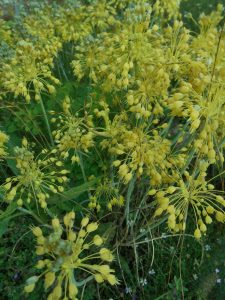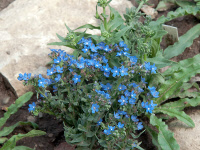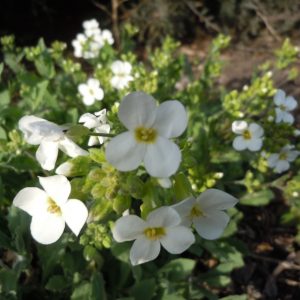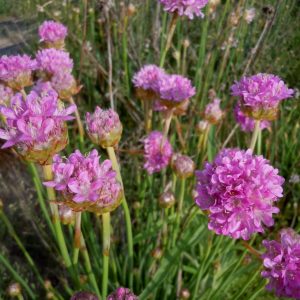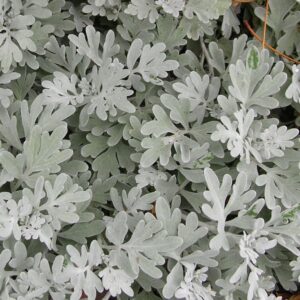Drought, Xeric & Dry Soil Plants
- Sorry, this product cannot be purchased.
Showing 9–16 of 132 results
-
Allium flavum var. minus Yellow flowered garlic
Umbels of shatter-shot yellow florets, like fireworks, bloom atop blue-green stems in July.
Umbels of shatter-shot yellow florets, like fireworks, bloom atop blue-green stems in July.
Size: 10” x 3”
Care: sun in moist well-drained soil
Native: Northern Turkey
Wildlife Value: resistant to rabbits & deer. Attracts bees and butterflies
Awards: species received Royal Horticultural Society Award of Garden MeritDescribed by Swiss botanist Pierre Edmond Boissier before 1885
-
Allium senescens Corkscrew allium, German garlic, Greater mountain garlic Z 4-9
Lavender balls, up to 30 of them, atop thin, bluish, strap-like, twisting foliage – mid-summer day’s dream.
Lavender balls, up to 30 of them, atop thin, bluish, strap-like, twisting foliage – mid-summer day’s dream.
Size: 6-12” x 6-12”
Care: sun to part shade in well-drained to moist well-drained soil
Native: Siberia
Wildlife Value: attracts butterflies & bees, deer & rabbit resistantCultivated before 1753. According to Philip Miller’s 1768 Dictionary, “planted in gardens for the variety of their flowers.”
-
Amsonia orientalis syn. Rhazya orientalis European bluestar Z 5-8
“Immensely tough and useful filler” “100 Plants Every Gardener Should Grow,” Gardens Illustrated No. 231 Purplish blue terminal flower clusters are larger and longer lasting than other Amsonia. Yellow foliage in Fall.
“Immensely tough and useful filler” “100 Plants Every Gardener Should Grow,” Gardens Illustrated No. 231
Purplish blue terminal flower clusters are larger and longer lasting than other Amsonia. Yellow foliage in Fall.Size: 12-20” x spreading
Care: sun to light shade in moist well-drained soil
Native: TurkeyDeer resistant, salt and heat tolerant. Classified as critically endangered as it is losing its native habitat and was over harvested. Collected before 1844.
-
Anchusa capensis Cape forget-me-not, Cape bugloss Z 6-9
Truest of blue flowers from summer through fall
OUT OF STOCK
Truest of blue flowers from summer through fall. Do you need to know anything else?
Reseeding annual in colder zones.
Size: 8” x 8”
Care: sun in well-drained to moist well-drained soil
Native: So. Africa.
Awards: Plant Select® Central Rocky Mountain regionCollected and introduced to Europe in 1794 by von Thunberg (1743-1828). Carl Peter von Thunberg, student of Linnaeus at Uppsala University in Sweden, made three trips to the Cape of Good Hope 1772-1775 where he collected about 1000 new species, Java and Ceylon (Sri Lanka) 1777 and 15 months in Japan where he befriended local doctors who gave him hundreds of plants new to Western horticulture. He succeeded Linnaeus as professor of medicine and botany at Uppsala and King Gustav beknighted him. Young Cape forget-me-not plants were eaten as a vegetable, Annals of the South African Museum, 1898. Louise Beebe Wilder loved this plant, effusing, “One of the prettiest (blue annuals) is the Cape Forget-me-not. Not one of its cerulean family boasts a purer blue and its summer-long period of bloom and indifference to drought make it a really valuable annual. It has also a sturdy habit of growth and sowing its hardy seeds freely it does its best to become a permanent resident.” Robinson called it “Remarkably fine…” The Garden 1873. The name Anchusa from anchousa paint used on skin.
-
Arabis caucasica syn. A. alpina subsp. caucasica Alpine Rock Cress (Bastard Tower Mustard, Miller 1768) Z 4-9
Late spring white four-petaled racemes. Perfect for a dry border or rock garden. Drought tolerant.
OUT OF STOCK
Late spring white four-petaled racemes. Perfect for a dry border or rock garden. Drought tolerant.
Size: 6-12”x 20” spreads
Care: Full sun well-drained soil, vigorous; cut back after flowering to make it full.
Native: Southern Europe and Mediterranean.
Size: Perfect for a dry border or rock garden. Drought tolerant.Arabis is Greek for Arabian. Cultivated in the U.S. since 1800’s.
-
Armeria pseudoarmeria syn. A. formosa syn. A. latifolia, A. alpina Alpine thrift, Giant thrift Z 5-7
Carmine-pink balls atop stems and taller than grass-like foliage flowering in June and sporadically all summer
OUT OF STOCK
Carmine-pink balls atop stems and taller than grass-like foliage flowering in June and sporadically all summer
Size: 12” x 8”
Care: full sun in well-drained soil, heat and drought tolerant
Native: So. EuropeIn gardens since 1740. Per Wm Robinson this plant: “one of the best hardy flowers from southern Europe and should be in every collection.”
-
Artemisia ludoviciana Silver sage, Wormwood Z 4-9
Grown for its silver-grey foliage
OUT OF STOCK
Grown for its silver-grey foliage in the garden & dried in arrangements
Size: 3’ x 2’ and spreading
Care: sun in well-drained soil
Native: Colorado south to Texas, west to California.Blackfoot cleaned themselves with this as part of religious rituals. California’s Shasta Indians prepared dead bodies to be buried with the leaves. HoChunk made a smudge to revive the unconscious. Cahuilla Indians made baskets and roofs and walls of their homes with the stems. First collected for gardens by Thomas Nuttall in early 1800’s. Artemisia named for the wife of Mausolus, king of Caria, who began using another Artemisia. Miller 1768.
-
Artemisia stellerana Beach wormwood, Dusty miller Z 3-7
Intricate, embroidery-like, felty-white foliage
Grown for its intricate, embroidery-like, felty-white foliage
Can not ship to: Maryland
Size: 24” x 12”
Care: sun in moist well-drained to dry soil
Native: naturalized in North America from Massachusetts to DelawareArtemisia named for the wife of Mausolus, king of Caria, who began using another Artemisia. Miller 1768. Collected from the wild by 1842. Recommended by Gertrude Jekyll to use on the edges of gardens, 1908 L.H. Bailey (1933) described it as “attractive for its whiteness. Useful for borders.”
**LISTED AS OUT OF STOCK BECAUSE WE DO NOT SHIP THIS ITEM. IT IS AVAILABLE FOR PURCHASE AT OUR RETAIL LOCATION.

